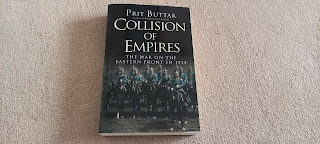THE EASTERN FRONT 1915.
This is the second in the series of four books I recently purchased covering the war on the Eastern Front 1914-1921. Once again a well written and exhaustively researched book with huge detail.
1915 started with terrible battles in the Carpathian mountains which more or less completed the destruction of the kuk (Austrian-Hungarian army) which had started in 1914. Neither side made any progress other than to increase the already vast casualty lists. During the summer the Germans launched an offensive, partially to stop the total collapse of the kuk but also to push the Russians back thereby reducing the pressure on the Eastern front so they could concentrate on the West. The offensive was very successful and resulted in the capture of most of Poland.
Later in the year the Germans and kuk launched an invasion of Serbia which resulted in the occupation of that country and the escape of the Serbian army to Corfu. The year ended with Germany returning troops to the West, the Russians and kuk exhausted and suffering from almost 2 million casualties each.
Generally speaking we all know of the dreadful losses on the Western front but these books show that the casualties in the East were at least as great if not larger. The conditions were brutal given the weather and terrain especially in the mountains. Although the Germans mounted a very successful campaign, advancing many miles over the summer, it was still necessary for them to halt every 70 or so miles in order to bring up further supplies. Each stop gave the Russians time to build more defenses which then had to be overcome.
As well as covering the fighting this book also goes into great detail about the politics, economics and strategies of the various nations which really adds to the overall value of this excellent and highly recommend series of books.






